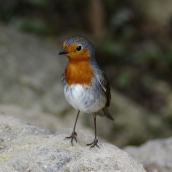Robin (Erithacus rubecula)
One of the smallest members of the family Turdidae, the robin measures 12.5-14 cm in total length. It is well-known for its orangey-red breast and face, which is less intensely red in the subspecies E. r. rubecula, but more so in the Canary Island endemic E. r. superbus. It has a whitish belly, brown flanks and bronze-coloured back. The tail is relatively long, and the bill is slim. Widespread throughout Europe, this species is found in the Azores and Madeira (subspecies E. r. rubecula). In the Canaries, however, there are two forms: the nominate is found in the westernmost islands (La Gomera, La Palma and El Hierro) and E. r. superbus is present in Tenerife and Gran Canaria. The existence of a new subspecies, which has yet to be formally described, has been suggested for Gran Canaria: E. r. marionae. During migration and winter seasons, this species also reaches the eastern islets of the Canaries, Gran Canaria and the Savage Islands; however, there is only one recent sighting for Cape Verde. The robin has adapted to many different environments in Macaronesia, both natural (from thermophile vegetation strongholds to high montane pine forests) and man-made (banana plantations and mid-altitude farmland, plantations of exotic trees, gardens, enclosed pastures, etc.). In the Azores and Madeira it is particularly common in evergreen and fayal-brezal firetree and heath forests, but in the Canaries it has shown considerably more ecological flexibility, though it is still very much a forest-dwelling species. It can be found at 2,000 m and not unusually near sea level, mainly in the Azores and Madeira. It mostly feeds on invertebrates, as well as the fruits of trees and shrubs, thereby contributing to seed dispersal. The clutch is of 2-6 eggs (usually three in the Canaries), but the subspecies E. r. rubecula can produce up to seven. The breeding season varies according to island group. In the Canaries breeding can begin in February (though April is far more usual), while in Madeira and the Azores it starts in April or May. Late clutches of eggs are found in July. The range and distribution of this species is widespread and it has no important threats, except for forest fires and predation by cats and rats.













